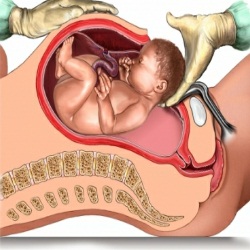Five Ways to Avoid a C-Section
Five Ways to Avoid a C-Section
by Katharina Bishop
A recent study shows that women who opt for an elective cesarean have a threefold higher risk of mortality than those who choose vaginal delivery. The study, conducted in France and led by Catherine Deneux-Tharaux, M.D., found that women who died during or within 42 days of giving birth were significantly more likely to have had a cesarean than women who survived childbirth (41.5% versus 14.9%).
The increased maternal mortality was caused primarily by venous thrombosis (25.9%), infection (14.8%), and anesthesia complications (14.8%). Postpartum hemorrhage was no higher for cesarean deliveries. None of these complications was among the most frequent causes of death after vaginal births (7.9%, 2.6% and 2.6% respectively).
Cesareans were associated with a significantly increased risk of postpartum maternal death compared with vaginal delivery even after adjusting for age, nationality, parity (number of births), and premature birth. The odds decreased only slightly after excluding (high risk) preterm births. Both cesarean deliveries initiated before onset of labor and those initiated during labor significantly increased risk of maternal death.
The authors concluded that although cesarean delivery is increasingly perceived as a low-risk procedure, it is still associated with an increased risk of postpartum maternal death compared with vaginal delivery, even when performed before the onset of labor. As the cesarean rate rises you may wonder what control you have over how you give birth. While not all cesareans can be avoided, many can. You have the ability to influence whether or not you give birth vaginally or by C-section. So what can you do when you want to avoid surgery?
Select your health care provider wisely.
Your health care provider will be instrumental in avoiding an unnecessary cesarean section. When interviewing your doctor or midwife, be sure to ask them what their primary cesarean rate is in their practice. This is the number of first cesareans, which gives you a more accurate picture of how often they perform this surgery as it leaves out repeat cesareans. The primary c-section number should be low, preferably under 10%. Individual hospitals also influence the cesarean rates with their policies for labor and birth care. It may prove helpful to talk to the participating hospitals and find out their C-section rates.
Educate yourself on labor and birth.
You can prepare, inform and educate yourself by taking a childbirth class (such as the Bradley method), by talking to women who have had a successful vaginal birth and by reading books on pregnancy and childbirth. By learning about the process of labor and birth in advance, you are more likely to be relaxed and feel comfortable with your surroundings and the birth process. With increased knowledge and understanding, you will be able to draw up a birth plan in which you can express your informed choices for your birth to your doctor or midwife.
Avoid induction of labor.
Induction of labor increases the C-section risk because of complications associated with the process of induction and/or the drugs used (2). You may wish to inform yourself on alternatives to induction of labor as well as the types of induction used. If your induction is for medical reasons, talk to your practitioner about what type of induction works best for your situation. Social or elective induction is used without medical indication to benefit your schedule or the schedule of your doctor or midwife. If you want to avoid an unnecessary cesarean, avoiding induction is one way to lower your risks of surgery.
Use medications and interventions wisely.
Medications such as spinal anesthesia (epidurals) can also increase the risk of having a cesarean section, especially if used too early in the birth process. If you wait to receive medications until you are in active labor (past five centimeters dilation), you can reduce some of the associated risks. Other interventions, such as artificially rupturing the membranes (bag of water), can also lead to an increase in the cesarean rate (3). Interventions such as these also increase the infection risks for you and baby (4).
Bring support for labor.
Emotional support is essential for a successful labor and birth. Having a professional doula (birth partner) present at your birth is scientifically proven to reduce your risk of having a C-section. The C-section rate for women who have a doula-attended birth is lowered by 50%. Doulas are trained professionals who are schooled in birth support using massage, positioning, relaxation, information and other skills to help make you more comfortable during your labor (see The Benefits Of Hiring A Doula For Your Birth for more information on the medical benefits of hiring a doula).


